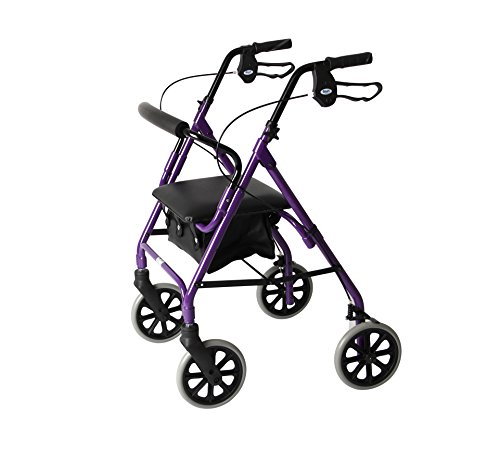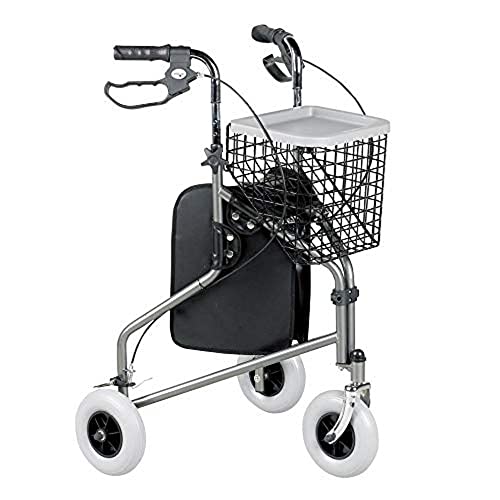Rollator Folding Tools To Ease Your Everyday Lifethe Only Rollator Fol…
Georgina
0
6
11.09 08:31
 Locking Mechanism For Use With a Foldable outdoor rollator
Locking Mechanism For Use With a Foldable outdoor rollatorThe majority of rollators come with an locking mechanism or latch that prevents them from slamming during storage. This is crucial to avoid a potentially hazardous situation during transportation.
The lock is situated in the middle of the frame. It could be a button or a lever. It is essential to understand how to use this feature.
How to fold a rollerator
Rollators are excellent mobility aids that offer stability and support for those who require it. They are easy to carry and portable and a variety of models are available to meet different requirements and budgets. Some people might be concerned about how to safely fold and unfold a walker that rolls.
Modern walkers have simple mechanisms for folding. They can be folded quickly without the use of any tools. This makes them ideal for storage and transportation. Moreover the locking mechanism makes sure that the walker when folded will not open during transport or storage, thereby providing security and security to users.
Modern rollator folding; https://mozillabd.science/, walkers aren't only easy to fold, but also come with ergonomic designs that guarantee the user's comfort and safety. For example, they have comfortable handles, a large basket, and a built-in brake lever to avoid accidental activation. They are also constructed of lightweight materials for portability and easy handling.
The traditional rollators for tall people weigh more and don't have the capacity to support themselves when folded. This makes them difficult to transport or store. Their seats are also connected to the frame which means that they can't be stored against objects or small spaces. Therefore, it's essential for people who use a rollator to know how to fold their walkers for more convenient storage and transport.
The first step to fold a rollator is to find the locking mechanism, which is typically located near the center of the device's frame. You can lift it gently or let it go by following the instructions of the manufacturer. After the locking mechanism is removed, you can fold your walker by pressing the sides together while holding the releases. Continue to do this until the walker is compact and securely locked.
Also, you should check your walker to determine if there are any loose parts or indications of wear and damage. If you spot any issues you need to fix them promptly to avoid further damage and injuries. In addition, it is recommended to regularly oil all moving parts of the walker to minimize friction and ensure the smooth operation.
The Crossbar
The crossbar is a central bar that supports the frame and wheels of a rollator walkers. The crossbar is generally made of steel and connects the handlebars to the frame's bottom. The crossbar adds strength and stability, and also holds the basket of the walker and other accessories. The majority of manufacturers offer a range of optional accessories for their walker models, which include storage baskets and tote bags. These can be attached on the front or the back of the walker or placed under the seat.
Many models of walker have a crossbar that can be folded in two directions. This makes them easier to store and transport. This is a significant feature, especially in the event that the walker will be frequently used for travel or long journeys to the grocery store or other places. Some models of walkers come with a removable bag which can be used as additional storage.
The brakes are another important aspect of a walker that is rolling. They are typically located on the crossbar and handles. There are various types of brakes, such as cable loop and push-down brakes. The brakes that are push-down require the user to apply downward pressure to the spring-loaded frame to stop the walker from sliding. This type of system may not be suitable for smaller users who struggle to engage the brakes or heavier users who may accidentally activate them.
A cable loop brake system works similar to the brakes of a bicycle. It can be engaged by pressing the handlebars and levers at the same time using both hands. This type of brake system is suitable for those with limited hand movement, and offers more control than the push-down brakes.
The term "crossbar" is used to describe the vertical stroke that is a cross between two strokes in the form of a letter. The position, length, and thickness of a crossbar can affect the legibility of any letterform. This is a major distinction between serif and nonserif fonts. The crossbar on the small e is commonly known as an arm.
The Release Mechanisms
Rollators are a great method to boost mobility and independence for those who have physical limitations. This unique stability device helps distribute weight evenly across a user's lower body, which reduces strain on muscles and joints, allowing for easy and comfortable movement. With features that can be customized, such as adjustable handlebars and handbrakes with built-in seating, as well as storage compartments they make it much easier for users to navigate their surroundings with ease and confidence. Additionally, these light and portable mobility aids are often covered by Medicare or Medicaid to aid in obtaining affordable.
In contrast to traditional walkers, which have a basket and seat and must be stowed in the trunk of your car carbon rollators fold in half for easy car transport or compact storage. To do this, take off the basket and pull up on the crossbar to expose two release mechanisms on either side of the frame. Press these release mechanisms while pushing the sides of the frame together until the walking aid shrinks to its smaller size.
The locking assembly is attached to a top support arm that is substantially horizontal, and 218 that joins two front and rear tubular legs that are substantially vertical. Connected to the ends of the rear and front tubular legs are tubular leg extensions telescoping in 226 and 228, respectively. The telescoping extension is able to be turned from an unlocked position to a locked position in order to adjust the height.
After the leg segments of the extension are placed in the right place, a nonsliding handle is attached to the end of actuating lever. The actuating lever attaches to the housing using an extension portion that extends out from the frame, and an recessed piece that is sized to accept the extension piece. The recessed portion and the extension piece serve as a fulcrum about which the actuating mechanism can be pivoted.
When the telescoping legs segments are in the right position, the locking mechanism engages a snap-button and biasing spring. This arrangement lets the user easily engage and disengage the mechanism that folds for easy storage and transportation of the walking aid.
The Locking Mechanism
The present invention is a locking mechanism that could be used with foldable walkers or rollators. The invention addresses a need for a lock assembly for use with these walkers and rollators that is simple to set up between unfolded and folded positions for those who be unable to move their hands.
In general, the device consists of two spaced side frames with the cross brace that connects them. It also comes with two handles. Two hand brakes are fixed to the handles and each has a pin actuating plunger that engages with the plunger on the respective cross bar. When the user presses on the hand brakes, the pin actuating spout is depressed causing the side frame rotate into a folded position.
This kind of device has one issue: the actuating handle must be held with one hand while trying to depress the plunger with pin-actuation. This can be problematic for those with limited hand strength or dexterity. The present invention resolves this issue by providing a locking assembly that can be operatively connected to the actuating mechanism.
As illustrated in FIG. As shown in FIG. A lock plate is situated inside the bore. It has an opening which can be used to receive the locking end of the locking pin. The portion of the actuating hand between the handle that applies force and the attachment end the body is designed to pivot in relation to both body components, such that the locking plate is moved from a first position where it blocks the tubular leg, to a different position where the telescoping leg can be extended.
 When the actuating lever is operated by the hands of the user, the locking pin is moved from the first position to the second position. In the process, the telescoping leg extension can be retracted from the side frame and turns it into a folded position. This can be done while the user's hand is still firmly gripping hand grip 24 of the side frame. This feature can drastically reduce the amount of work required to fold a rollator into and out of its folded position.
When the actuating lever is operated by the hands of the user, the locking pin is moved from the first position to the second position. In the process, the telescoping leg extension can be retracted from the side frame and turns it into a folded position. This can be done while the user's hand is still firmly gripping hand grip 24 of the side frame. This feature can drastically reduce the amount of work required to fold a rollator into and out of its folded position. 